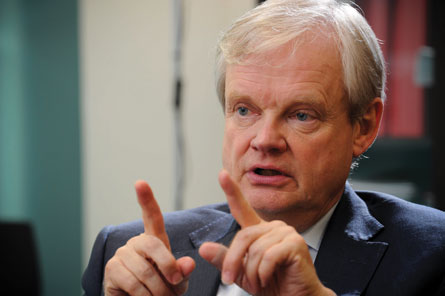Emirates continues to defy superlatives. The Dubai flag-carrier rode out its city's infamous financial crisis of 2009 and the wider global downturn while the rest of the sector struggled, increasing traffic and becoming the world's most profitable major airline by some margin. Now the carrier - which last year stunned the industry with an order for 32 more Airbus A380s to take its total commitment for the European superjumbo to 90 - is entering what divisional senior vice-president flight operations Capt Alan Stealey calls a "massive couple of years". Two widebody aircraft are due for delivery virtually every month between now and May 2012. Towards the end of that period, the rate could rise to as many as four a month.
The speed of expansion is a challenge for a business that already operates 153 twin-aisle airliners, in terms of introducing the new equipment and recruiting the pilots to fly them, as well as the cabin crew, engineers and head office staff to keep them in service. "Managing that is one of the hardest things we have to do," admits Stealey. "I joined seven years ago when we were a third of our present size in terms of pilots. We have had to change the way we do business and we rely on IT much more now for planning, crew rostering, everything."
Emirates expects to recruit 500 new first officers a year for its growing fleet - it rarely takes on direct-entry captains. Each new aircraft requires a complement of 26 flightcrew and, says Stealey. Every time an ultra-long-haul route such as Los Angeles is added, up to 60 pilots are needed.
"Low-cost carriers are a good source of young first officers," says Stealey. "We can offer them a chance to fly the latest widebodies, on intercontinental routes, which can be very attractive to someone flying around Europe for an LCC." Another attraction is career stability. "The time to upgrade is around five years, driven by our expansion, so a relatively young guy joining us could expect to get a command in his late 30s," he says.
 |
|---|
©BillyPixCapt Alan Stealey: "We have had to change the way we do business" |
To find candidates, Emirates has been holding a series of recruitment roadshows from London to Las Vegas. Would-be recruits who pass an initial screening are invited to visit Dubai, which the airline believes is an important part of the selection process, not just so it can put candidates through a more formal interview and tests, but so that pilots can "get a feel for the whole Dubai culture", says Stealey. Emirates likes all its pilots to be based within reach of its hub - with a chauffeur to drive them to and from work and a dedicated flightcrew check-in beneath its headquarters with a direct link to airside helping to ease any pre- and post-flight stress and fatigue.
But getting invited to Dubai is no guarantee of success, with Emirates rejecting about half of all pilot candidates who reach this stage. The airline has to be convinced that pilots will be able to cope not just with demanding long-haul rosters on modern aircraft, but that they will fit into a multi-cultural crew environment. "We are clear that we must have no compromise in standards as we expand," says Stealey. "But, luckily, we are at the top of the pyramid in terms of who we can attract."
Emirates tends to keep its Airbus and Boeing pilot cohorts apart, although occasionally an Airbus pilot will be trained to switch onto a Boeing, and vice versa. No first officers are recruited directly onto the A380, partly because of a waiting list of existing Emirates pilots, including from the Boeing fleet, who are keen to take the controls of the world's biggest airliner. The airline will take delivery of its 16th A380 in September, with further examples arriving at a rate of roughly one a month after that.
Two years after it had to turn to its neighbour in Abu Dhabi for a bail-out after the bursting of a property bubble that Dubai's investors and state institutions had bankrolled, the emirate appears to be recovering. Although giant "To let" signs adorn many of its newly built high-rises, the world's tallest tower and a high-tech overground metro have become the most recent additions to a city containing some of the region's iconic structures. Tourism is booming, and for expatriates who want the best shopping, the best beach life and the best entertainment in the Middle East, Dubai remains the destination of choice.
With its international airport - where Emirates is based in the new terminal 3 - busier than ever and racing towards capacity, Dubai has its long-term future mapped out. On the edge of the city, near the Jebel Ali port, the huge Al Maktoum International airport is emerging out of the desert. Although progress has slowed since the financial crisis, what is earmarked to be Emirates' eventual home will give the airline scope in the next decades to expand its fleet several-fold - a far cry from the congested, ageing terminals its European competitors will have to contend with.
Source: Flight International























